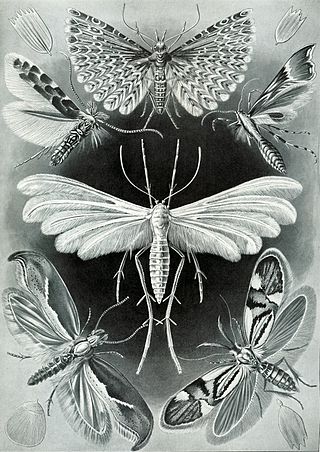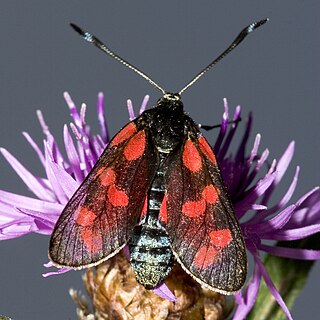
Microlepidoptera (micromoths) is an artificial grouping of moth families, commonly known as the "smaller moths". These generally have wingspans of under 20 mm, so are harder to identify by external phenotypic markings than macrolepidoptera. They present some lifestyles that the larger Lepidoptera do not have, but this is not an identifying mark. Some hobbyists further divide this group into separate groups, such as leaf miners or rollers, stem or root borers, and then usually follow the more rigorous scientific taxonomy of lepidopterans. Efforts to stabilize the term have usually proven inadequate.

The Zygaenoidea comprise the superfamily of moths that includes burnet moths, forester moths, and relatives.

The Dalceridae are a small family of zygaenoid moths with some 80 known species encompassing about one dozen genera mostly found in the Neotropical region with a few reaching the far south of the Nearctic region.
Cyclotorna is a genus of moths, the sole one of family Cyclotornidae, with five recognized species, all endemic to Australia. This family and the closely related Epipyropidae are unique among the Lepidoptera in that the larvae are ectoparasites, the hosts in this case typically being leafhoppers, sometimes scale insects. The larvae of cyclotornids, however, leave the hemipteran host and become predatory on the brood in ant nests, apparently using chemical cues to induce the ants to carry the larvae into the ant nest.
Palaeopsyche is a genus of moths in the family Epipyropidae. It consists of only one species Palaeopsyche melanias, which is found in the wet tropics of Queensland.
Heteropsyche micromorpha is a moth in the family Epipyropidae. It is found in Australia.
Heteropsyche poecilochroma is a moth in the family Epipyropidae. It is found in Australia.
Heteropsyche stenomorpha is a moth in the family Epipyropidae. It is found in Australia.
Epipomponia multipunctata is a moth in the family Epipyropidae first described by Herbert Druce in 1887. It is found in Panama.
Protacraga micans is a moth in the family Epipyropidae. It was described by Walter Hopp in 1924. It is found in Brazil.
Epiricania melanoleuca is a moth in the family Epipyropidae. It was described by Thomas Bainbrigge Fletcher in 1939. It is found in India, where its larvae are external parasitoids of the sugarcane planthopper. It has been used in biological pest control against this pest.
Epipyrops radama is a moth in the Epipyropidae family. It was described by Viette in 1961. It is found in Madagascar.

Epipomponia is a genus of moths in the Epipyropidae family.
Epiricania is a genus of moths in the family Epipyropidae described by Kato in 1939.
Epimesophantia is a genus of moths in the Epipyropidae family.
Epipomponia elongata is a moth in the family Epipyropidae. It was described by Karl Jordan in 1928. It is found in South America.

Epipomponia nawai is a moth in the Epipyropidae family. It was described by Harrison Gray Dyar Jr. in 1904. It is found in Japan, Taiwan, China, and Korea.

Epipyrops exigua or Fulgoraecia exigua, the planthopper parasite moth, is a moth in the Epipyropidae family. It was described by Henry Edwards in 1882. It is found in North America, where it has been recorded from New Jersey and Pennsylvania to central Florida, west to Missouri, Texas, New Mexico, Arizona and California.
Paraflata is a genus of planthoppers in the family Flatidae. It was first described by Leopold Melichar in 1901. Species in the genus are found on Madagascar.







